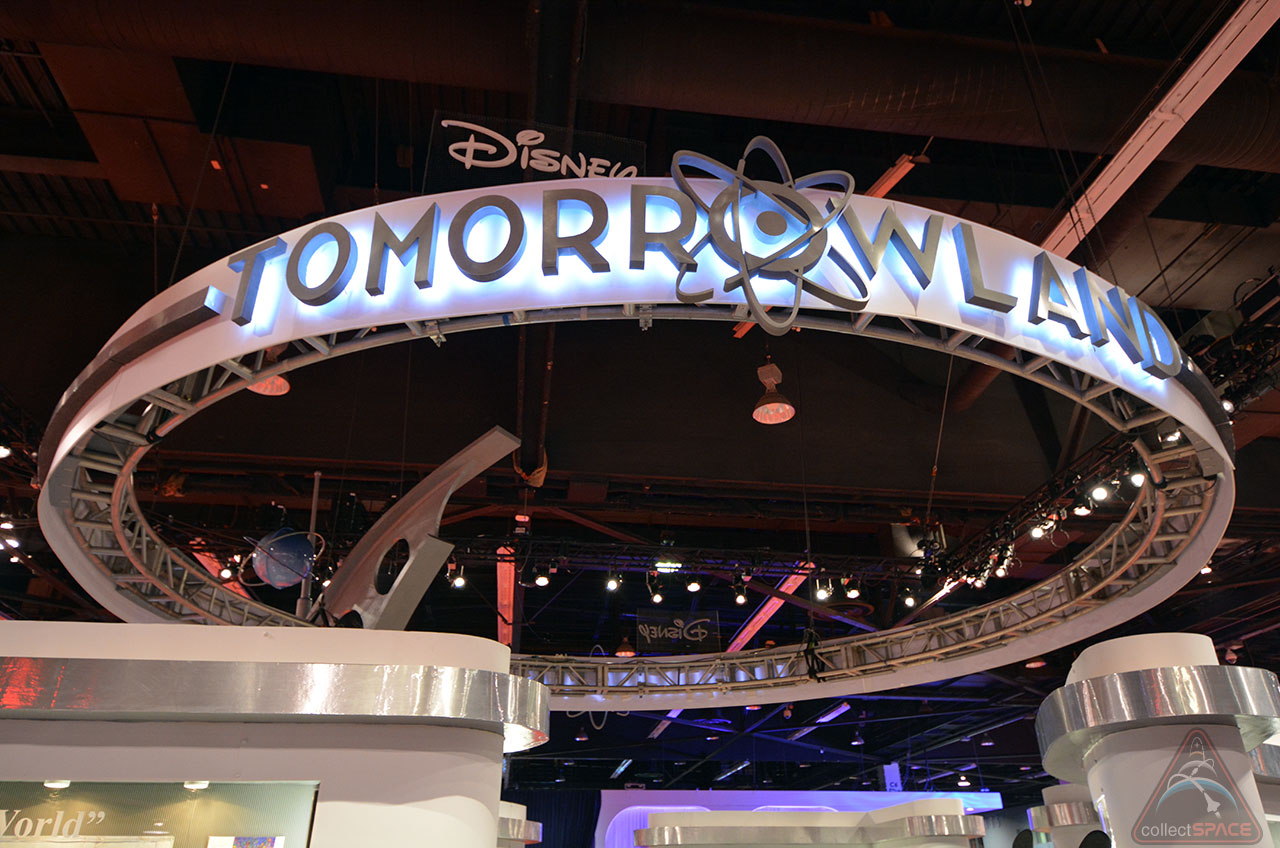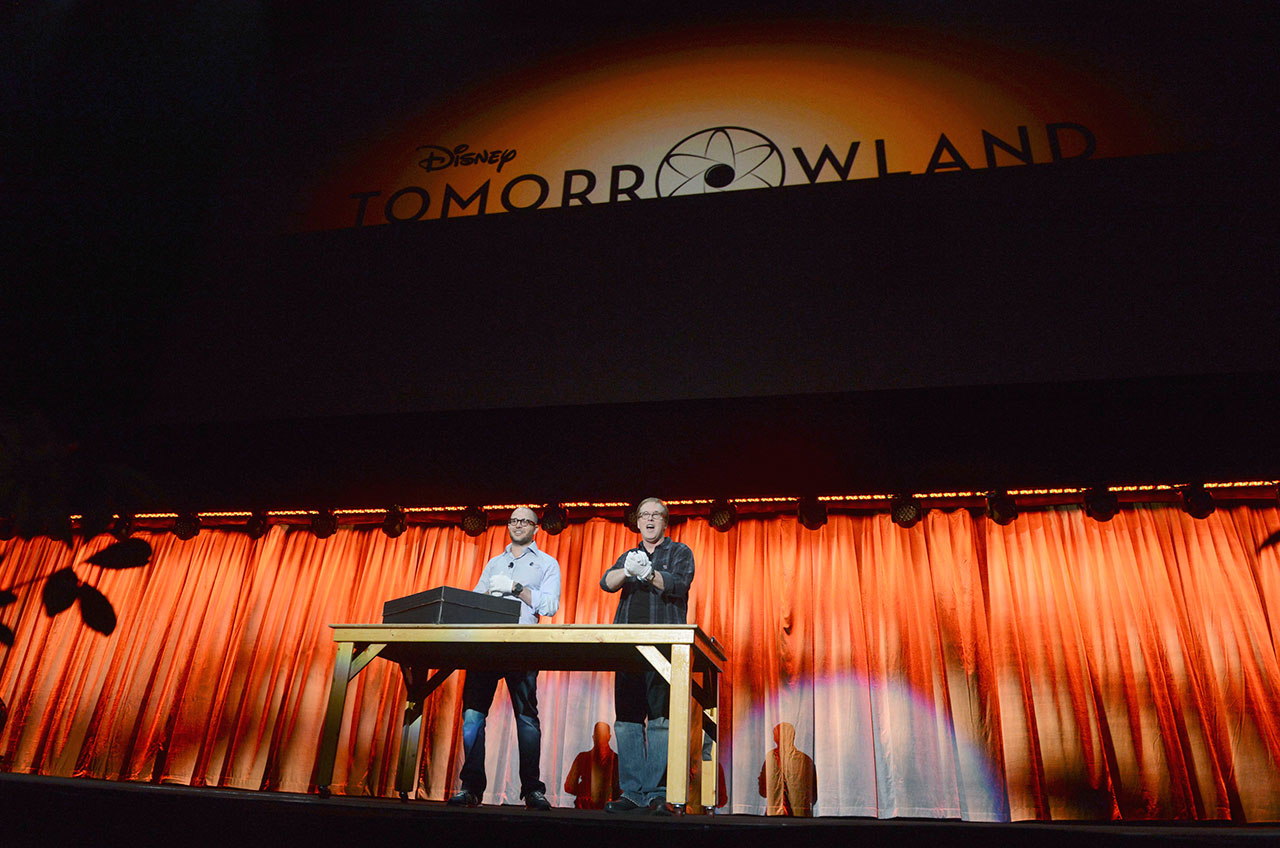Disney's 'Tomorrowland' Movie Inspired by Space Memorabilia

What do a rocket thruster, a lapel pin depicting a stylized rocket launch and a letter from rocket scientist Wernher von Braun have to do with the plot for a 2014 Disney movie?
That's the question "Tomorrowland" director Brad Bird and producer Damon Lindelof posed on Saturday (Aug. 10) with the surprise exhibit of the space memorabilia and more at the Walt Disney Company's D23 Expo, billed as "The Ultimate Disney Fan Event." The reveal was part of a "pop-up museum" that joined the expo's other booths at the Anaheim Convention Center in California.
A follow-up to a photo of a "dusty old box" Bird posted to Twitter in January, the "Tomorrowland" museum displayed the same box and its contents, which was allegedly found in the Disney Archives. The eclectic collection of artifacts, which ranged from the blueprints for the 1964 World's Fair to an Audio-Animatronic robot arm to a 1928 copy of the pulp magazine "Amazing Stories," provided the inspiration for the "Tomorrowland" movie, Bird and Lindelof said. [Walt Disney Meets Rocket Scientist Werner von Braun (Photo)]
"We brought out a dusty old box from the archives," Lindelof said. "Essentially, this was the genesis for the movie. They discovered this [box] in the [Walt Disney Archives] 'Morgue' and it had this piece of masking tape on it that said '1952,' but in that box were all these amazing things that completely fired up our imagination and became sort of the inspiration point for this movie."
"We don't know how much of it's real, how much of it were projects, whether it was a joke, but the stuff got our brains firing," added Bird.
"It's our job to say, 'What if everything in the box was real, what would it mean?'" Lindelof said.
Not many details have been released about the resulting live action film, which is set for release on Dec. 12, 2014. The sci-fi movie will star George Clooney as an inventor, Britt Robertson as the movie's heroine and Hugh Laurie as the antagonist.
Get the Space.com Newsletter
Breaking space news, the latest updates on rocket launches, skywatching events and more!
The film's logo, which was also revealed at the D23 Expo, features an atom-like icon that doubles as the third "O" in "Tomorrowland" and what appears as the sun rising over a horizon.
Space in the box
Bird and Lindelof highlighted some of the artifacts alleged to have been found in the box during a presentation Saturday morning (Aug. 10), including showing a never-before-seen Disney animation, entitled "A History of Tomorrow." The filmmakers said Pixar Animation Studios had restored the animation after it was discovered on a badly-scratched 1960s prototype video storage disc. [Disney's Buzz Lightyear Toy In Space (Photos)]
The animation, which showed the rise of civilization, also told of a meeting between Nikola Tesla, Thomas Edison, Jules Verne and Gustave Eiffel at the 1889 World's Fair in Paris, where they began work on a project of an unknown nature.
The unlikely meeting (Tesla and Edison were known to be bitter rivals) was not the only reference to real-life figures held in the box.
A photograph also found in the box showed Walt Disney and Amelia Earhart together, although it was dated years after the aviatrix disappeared. Bird and Lindelof said the image was clearly a fake, producing the original images from which Disney's head and actor Cary Grant's body had been swapped, but could not explain why it existed.
The artifacts also pointed to another figure from history: rocket scientist Wernher von Braun. The animation was drawn in the style of the "Tomorrowland" TV specials that Disney collaborated with von Braun to produce, and in the exhibit of the box's contents were scripts and storyboards from that "Man in Space" series.
Also on display was a note on NASA letterhead inviting Disney to meet with Wernher von Braun to tour the Marshall Space Flight Center in Alabama, a real-life event that took place in April 1965.
Elsewhere in the pop-up museum was a photo of a lapel pin, which itself depicted a rocket similar in style to von Braun's early proposed designs from the 1950s. Exhibited nearby was what was labeled as a reaction control system thruster, similar in style to the real RS-34 rocket engine, as part of the plans for a canceled "Jet-Man" Disneyland attraction, which would have simulated the experience of soaring through the sky using a rocket-powered jet pack.

Where's my jetpack?
How these artifacts — which are also described in the free "Tomorrowland D23" app released by Disney for the Apple iPhone — relate to the plot of the "Tomorrowland" movie is still be seen. The references to the early space age are purposeful though, Lindelof said.
"I think 'Tomorrowland' really evokes an idea of the future that is much different than the view of the future we have now, projected out from the year 2013," the producer said. "The 'Tomorrowland' future is really evocative of the space age, that 'right stuff' era."
"That idea of 'Where's my jetpack?' — what happened to that future?" Lindeloff said in a Disney-released interview.
Lindelof, who previously kept audiences guessing as the co-creator of the television series "Lost," said that secret-keeping was part of the Disney legacy.
"WED [Walt E. Disney Imagineering] was really this black ops division of the Disney company. Nobody really knew what they were doing," Lindelof said. "That idea of building something and keeping it veiled until you're ready to show it... that's the type of storytelling I really gravitate to, it is what gets my heart beating and it is certainly the type of storytelling I like to do."
"That was really the genesis for the feel we were going for in 'Tomorrowland,'" Lindelof said.
Click through to collectSPACE.com to see photos of the “Tomorrowland” pop-up museum and space artifacts from the “dusty old box” inspiring the 2014 Disney movie.
Follow collectSPACE.com on Facebook and on Twitter at @collectSPACE. Copyright 2013 collectSPACE.com. All rights reserved.
Join our Space Forums to keep talking space on the latest missions, night sky and more! And if you have a news tip, correction or comment, let us know at: community@space.com.

Robert Pearlman is a space historian, journalist and the founder and editor of collectSPACE.com, a daily news publication and community devoted to space history with a particular focus on how and where space exploration intersects with pop culture. Pearlman is also a contributing writer for Space.com and co-author of "Space Stations: The Art, Science, and Reality of Working in Space” published by Smithsonian Books in 2018.In 2009, he was inducted into the U.S. Space Camp Hall of Fame in Huntsville, Alabama. In 2021, he was honored by the American Astronautical Society with the Ordway Award for Sustained Excellence in Spaceflight History. In 2023, the National Space Club Florida Committee recognized Pearlman with the Kolcum News and Communications Award for excellence in telling the space story along the Space Coast and throughout the world.










